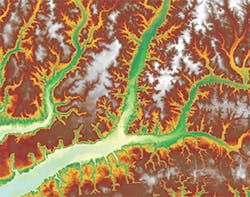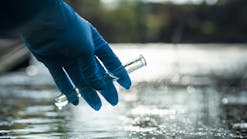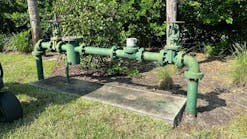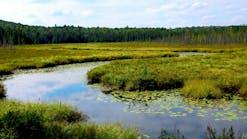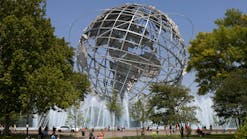The Northwest Florida Water Management District, charged with responsibilities for water supply, water quality, flood control, and ecological protection in Florida’s Panhandle, needed better topographic information to fulfill its mission.
The district partnered with other agencies to fund a comprehensive LiDAR project and share the data publicly. “The need to develop accurate flood maps for the Panhandle led to the district working with FEMA and the Florida Division of Emergency Management to acquire funding for the use of LiDAR technology,” says communications director Jim Lamar. The USGS and local communities also contributed.
The Northwest Florida Water Management District, charged with responsibilities for water supply, water quality, flood control, and ecological protection in Florida’s Panhandle, needed better topographic information to fulfill its mission. The district partnered with other agencies to fund a comprehensive LiDAR project and share the data publicly. “The need to develop accurate flood maps for the Panhandle led to the district working with FEMA and the Florida Division of Emergency Management to acquire funding for the use of LiDAR technology,” says communications director Jim Lamar. The USGS and local communities also contributed. [text_ad] Topography in the Panhandle is complicated by many rivers, wetlands, and coastal marshes, plus developed cities and infrastructure. The district considered the LiDAR project a priority for managing water resources there. Lamar says that the district aimed “to not only create updated and more accurate flood maps but also obtain more detailed topographic and elevation data for all of our jurisdiction in northwest Florida.” After data collection, the district developed an online mapping system to deliver the topography, imagery, and other geospatial information to the public. “The primary focus was the ease of use and access to the imagery as well as the ability to create maps through GIS and Web-based platforms,” says Lamar. The district completed the project in 2011 and continues to benefit from the high-quality data it produced. “The district uses LiDAR data as the starting point for a variety of projects,” explains Lamar, “including hazard-mitigation planning and the implementation of mitigation projects, emergency response planning, recovery and redevelopment projects, hydrologic and hydraulic projects, stormwater master planning, and other environmental planning and analysis projects.” Another organization that has put LiDAR to good use is the Minnesota Pollution Control Agency (MPCA), which used LiDAR in a statewide watercourse inventory completed in 2013. Over 160 years of development in Minnesota had modified, rerouted, or even created many watercourses, but the extent of the alterations was unknown. Monitoring and managing these resources was difficult without adequate information. “The State of Minnesota did not have a thorough accounting of streams that have been altered,” says MPCA research scientist Benjamin Lundeen. Prior to the project, MPCA staff used several tactics to determine whether a stream was altered. The process was subjective, time consuming, and produced inconsistent results. The MPCA wanted to catalog all watercourses in the state and reliably determine which ones were natural or altered, but sending field crews to inspect all 105,000 stream miles was impractical. Instead, the MPCA partnered with the Minnesota Geospatial Information Office (MnGeo) to leverage new GIS and LiDAR capabilities. The team first undertook a pilot project in three watersheds to assess the feasibility of using geospatial resources to complete the proposed inventory. The pilot project produced new reference data, GIS workflows, and a successful methodology. The full-scale project began in 2011. “The objectives of the Altered-Watercourse Project were to develop a GIS-based methodology for determining stream channel alteration, which focused on visual interpretation of contemporary and historic aerial imagery, including LiDAR, as well as several other reference layers,” says Lundeen. “This methodology was used to review all of the national hydrography stream linework within the State of Minnesota.” Statewide LiDAR coverage at 3.3-foot horizontal resolution proved to be indispensable in the process. “LiDAR was used to determine whether a particular stream had ever been altered,” explains Lundeen. “There are often telltale signs of alteration, such as soil piles or evidence of the old channel. This was also used to determine whether a stream would actually have water in the channel throughout the year. LiDAR data also provided visual evidence of old channels that were cut off as part of the alteration event.” Among other criteria, LiDAR helped detect changes in channel width and sinuosity—a river’s natural S-shape. A straight, narrow, or otherwise unnatural shape was one indicator of an altered watercourse. The project concluded that 50% of Minnesota’s watercourses were altered. Each watercourse was categorized as altered, natural, impounded, or indefinable. Minnesota agencies have found several uses of LiDAR beyond the Altered-Watercourse Project. LiDAR has supported erosion analysis, wetland mapping, flood control, and siting of best management practices. The MnGeo expects the uses to increase exponentially as LiDAR data become available for more areas of the state. The MPCA also expects increased use. “We anticipate a growing use of LiDAR dataset within the MPCA’s continued water quality and assessment work,” says Lundeen.Topography in the Panhandle is complicated by many rivers, wetlands, and coastal marshes, plus developed cities and infrastructure. The district considered the LiDAR project a priority for managing water resources there. Lamar says that the district aimed “to not only create updated and more accurate flood maps but also obtain more detailed topographic and elevation data for all of our jurisdiction in northwest Florida.”
After data collection, the district developed an online mapping system to deliver the topography, imagery, and other geospatial information to the public. “The primary focus was the ease of use and access to the imagery as well as the ability to create maps through GIS and Web-based platforms,” says Lamar.
The district completed the project in 2011 and continues to benefit from the high-quality data it produced. “The district uses LiDAR data as the starting point for a variety of projects,” explains Lamar, “including hazard-mitigation planning and the implementation of mitigation projects, emergency response planning, recovery and redevelopment projects, hydrologic and hydraulic projects, stormwater master planning, and other environmental planning and analysis projects.”
Another organization that has put LiDAR to good use is the Minnesota Pollution Control Agency (MPCA), which used LiDAR in a statewide watercourse inventory completed in 2013. Over 160 years of development in Minnesota had modified, rerouted, or even created many watercourses, but the extent of the alterations was unknown. Monitoring and managing these resources was difficult without adequate information.
“The State of Minnesota did not have a thorough accounting of streams that have been altered,” says MPCA research scientist Benjamin Lundeen. Prior to the project, MPCA staff used several tactics to determine whether a stream was altered. The process was subjective, time consuming, and produced inconsistent results.
The MPCA wanted to catalog all watercourses in the state and reliably determine which ones were natural or altered, but sending field crews to inspect all 105,000 stream miles was impractical. Instead, the MPCA partnered with the Minnesota Geospatial Information Office (MnGeo) to leverage new GIS and LiDAR capabilities.
The team first undertook a pilot project in three watersheds to assess the feasibility of using geospatial resources to complete the proposed inventory. The pilot project produced new reference data, GIS workflows, and a successful methodology. The full-scale project began in 2011.
“The objectives of the Altered-Watercourse Project were to develop a GIS-based methodology for determining stream channel alteration, which focused on visual interpretation of contemporary and historic aerial imagery, including LiDAR, as well as several other reference layers,” says Lundeen. “This methodology was used to review all of the national hydrography stream linework within the State of Minnesota.”
Statewide LiDAR coverage at 3.3-foot horizontal resolution proved to be indispensable in the process. “LiDAR was used to determine whether a particular stream had ever been altered,” explains Lundeen. “There are often telltale signs of alteration, such as soil piles or evidence of the old channel. This was also used to determine whether a stream would actually have water in the channel throughout the year. LiDAR data also provided visual evidence of old channels that were cut off as part of the alteration event.”
Among other criteria, LiDAR helped detect changes in channel width and sinuosity—a river’s natural S-shape. A straight, narrow, or otherwise unnatural shape was one indicator of an altered watercourse. The project concluded that 50% of Minnesota’s watercourses were altered. Each watercourse was categorized as altered, natural, impounded, or indefinable.
Minnesota agencies have found several uses of LiDAR beyond the Altered-Watercourse Project. LiDAR has supported erosion analysis, wetland mapping, flood control, and siting of best management practices. The MnGeo expects the uses to increase exponentially as LiDAR data become available for more areas of the state. The MPCA also expects increased use. “We anticipate a growing use of LiDAR dataset within the MPCA’s continued water quality and assessment work,” says Lundeen.